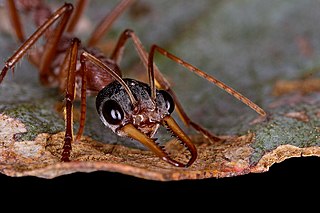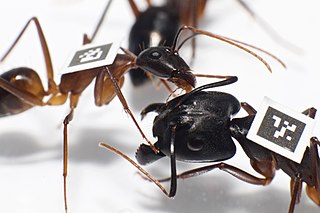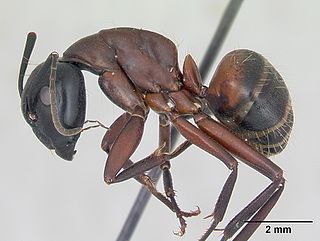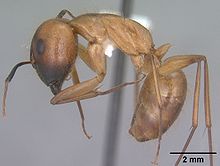
Ants are eusocial insects of the family Formicidae and, along with the related wasps and bees, belong to the order Hymenoptera. Ants evolved from vespoid wasp ancestors in the Cretaceous period. More than 13,800 of an estimated total of 22,000 species have been classified. They are easily identified by their geniculate (elbowed) antennae and the distinctive node-like structure that forms their slender waists.

Fire ants are several species of ants in the genus Solenopsis, which includes over 200 species. Solenopsis are stinging ants, and most of their common names reflect this, for example, ginger ants and tropical fire ants. Many of the names shared by this genus are often used interchangeably to refer to other species of ant, such as the term red ant, mostly because of their similar coloration despite not being in the genus Solenopsis. Both Myrmica rubra and Pogonomyrmex barbatus are common examples of non-Solenopsis ants being termed red ants.

Cuatro Ciénegas is a city in the northern Mexican state of Coahuila. It stands at 26°59′N102°03′W, at an average elevation of 740 metres (2,430 ft) above sea level. The city serves as the municipal seat for the surrounding municipality of the same name.

Formica rufa, also known as the red wood ant, southern wood ant, or horse ant, is a boreal member of the Formica rufa group of ants, and is the type species for that group, being described already by Linnaeus. It is native to Eurasia, with a recorded distribution stretching from the middle of Scandinavia to the northern Iberia and Anatolia, and from Great Britain to Lake Baikal, with unconfirmed reportings of it also to the Russian Far East. There are claims that it can be found in North America, but this is not confirmed in specialised literature, and no recent publication where North American wood ants are listed mentions it as present, while records from North America are all listed as dubious or unconfirmed in a record compilation. The workers' heads and thoraces are colored red and the abdomen brownish-black, usually with dark patches on the head and promensonotum, although some individuals may be more uniform reddish and even have some red on the part of the gaster facing the body. In order to separate them from closely related species, specimens needs to be inspected under magnification, where difference in hairiness are among the telling characteristics, with Formica rufa being hairier than per example Formica polyctena but less hairy than Formica lugubris. Workers are polymorphic, measuring 4.5–9 mm in length. They have large mandibles, and like many other ant species, they are able to spray formic acid from their abdomens as a defence. Formic acid was first extracted in 1671 by the English naturalist John Ray by distilling a large number of crushed ants of this species. Adult wood ants primarily feed on honeydew from aphids. Some groups form large networks of connected nests with multiple queen colonies, while others have single-queen colonies.
Autothysis or suicidal altruism is the process where an animal destroys itself via an internal rupturing or explosion of an organ which ruptures the skin. The term was proposed by Ulrich Maschwitz and Eleonore Maschwitz in 1974 to describe the defensive mechanism of Colobopsis saundersi, a species of ant. It is caused by a contraction of muscles around a large gland that leads to the breaking of the gland wall. Some termites release a sticky secretion by rupturing a gland near the skin of their neck, producing a tar effect in defense against ants.

Myrmecia is a genus of ants first established by Danish zoologist Johan Christian Fabricius in 1804. The genus is a member of the subfamily Myrmeciinae of the family Formicidae. Myrmecia is a large genus of ants, comprising at least 93 species that are found throughout Australia and its coastal islands, while a single species is only known from New Caledonia. One species has been introduced out of its natural distribution and was found in New Zealand in 1940, but the ant was last seen in 1981. These ants are commonly known as bull ants, bulldog ants or jack jumper ants, and are also associated with many other common names. They are characterized by their extreme aggressiveness, ferocity, and painful stings. Some species are known for the jumping behavior they exhibit when agitated.

Carpenter ants are large ants indigenous to many forested parts of the world.

The banded sugar ant, also known as the sugar ant, is a species of ant native to Australia. A member of the genus Camponotus in the subfamily Formicinae, it was described by German entomologist Wilhelm Ferdinand Erichson in 1842. Its common name refers to the ant's liking for sugar and sweet food, as well as the distinctive orange-brown band that wraps around its gaster.

The black carpenter ant is one of the largest and most common species of carpenter ant native to the central and eastern United States as well as eastern Canada.

Myrmecia nigriceps, also known as the black-headed bull ant, is a species of ant endemic to Australia. A member of the genus Myrmecia in the subfamily Myrmeciinae, it was first described by Austrian entomologist Gustav Mayr in 1862. These ants are large, varying from 19 to 23 millimetres in length. However, colonies contain workers that are much smaller, usually half the size of normal workers. The queens are the largest while the males are the smallest, which can be easily identified due to their small mandibles.
Colobopsis anderseni, synonym Camponotus anderseni, is a species of mangrove ant found in northern Australia.

Synoeca cyanea, commonly known as the marimbondo-tatu in Brazil, is a swarm-founding eusocial wasp. Native to Brazil and Argentina, S. cyanea is one of the largest and most aggressive species of social wasps and is feared in many rural areas. It begins its colony cycle in the early spring and continues until nest abandonment. Throughout its life, S. cyanea forage sugary substances and animal carcasses for food and wood pulp for its nest. S. cyanea is also known for its strong venom, which is enough to cause haemolytic activity.

Polybia sericea is a social, tropical wasp of the family Vespidae that can be found in South America. It founds its colonies by swarming migrations, and feeds on nectar and arthropods.

Camponotus floridanus, or Florida carpenter ant, is a species of ant in the genus Camponotus. First described as Formica floridana by Buckley in 1866, the species was moved to Camponotus by Mayr in 1886. The ant is widespread in Florida and occurs as far north as North Carolina and as far west as Mississippi.

The black-headed sugar ant, also known as the brown sugar ant, is a species of Formicinae ant endemic to Australia. Found throughout most states, the species is a member of the genus Camponotus, a cosmopolitan genus of ants commonly known as carpenter ants. It was formally described and named by British entomologist Frederick Smith in 1858. These ants are characterised by their black head, reddish-brown mesosoma and black gaster, which can change in colour.

Camponotus castaneus, the red hazelnut carpenter ant, is a species of carpenter ant located in the eastern United States. It is a primarily orangish-red ant in the family Camponotus. Its workers are usually around 8-10 mm, and queens around 18-20 mm. As with most Camponotus species, C. castaneus has majors and super-majors, usually appearing in the second or third year of the colony's founding, majors are usually 10-14 mm, with super majors being around 13-17 mm. C. castaneus has a generalist diet, feeding on insects and carbohydrates such as honeydew, which is easily accessible. The ant has a smooth thorax and abdomen, with 1 node separating them.

Camponotus dumetorum is a species of carpenter ant native to North America. They are related to other species from the subgenus Tanaemyrmex in western North America such as C. semitestaceus and C. vicinus. C. dumetorum are primarily nocturnal and form nests underground. Like other select ant species native to California, their populations have been displaced with the introduction of Argentine ants.

Camponotus fellah is a species of carpenter ant found across the Middle East and North Africa. This species was formally described by Dalla Torre in 1893. A C. fellah queen holds the record for Israeli ant longevity, surviving for 26 years (1983-2009) in a laboratory environment.

Camponotus ligniperda, the brown-black carpenter ant, is a common species of carpenter ant distributed widely throughout Europe. Found in a variety of woodland habitats, they commonly nest on the ground in dry tree stumps, dead fallen trees, or beneath stones and wooden logs that are partially buried. C. ligniperda is an ecologically dominant species wherever it is found due to both its large size and particularly aggressive nature.

Camponotus microps is a species of carpenter ant native to Arizona, New Mexico, Sonora, Queretaro, and Guanajuato. This species was separated from the Camponotus festinatus complex in 2006 by Roy Snelling.


















